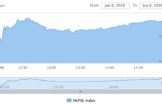World Bank forecasts slow growth in sub-Saharan Africa in 2016

NAIROBI, June 9 (Xinhua) — The World Bank has given the forecast of the economic growth in sub-Saharan Africa at 2.5 percent in 2016, down from 3.0 percent in 2015.
The latest update of its Global Economic Prospects report cited low commodity prices, tightening global financial conditions and drought in parts of the region for the forecast.
Commodity prices staged a modest rebound in February and March, but are still low and expected to remain subdued in the medium-term. Production has continued to fall in a number of commodity exporters, according to the World Bank report issued on Thursday.
The burden of the drop in prices has been further exacerbated by reduced capital inflows, with cross-border bank lending and bond issuance declining as well.
“Investment growth is expected to slow as governments and investors cut or delay capital expenditures in a context of fiscal consolidation,” the report said.
“A further oil price decline could strain the fiscal and current account balances of oil producers and force more public spending cuts,” it added.
The report says growth is expected to pick up in Ghana at a rate of 5.2 percent thanks to improved investor sentiment, new oilfields, and more reliable electrical power.
Cote d’Ivoire (8.5 percent) and Kenya (5.9 percent) are expected to continue to expand at a robust pace, boosted by ongoing investment and agricultural production.
Growth in Zambia is expected to remain subdued (3.4 percent) as a result of lower copper prices and power shortages.
Nigeria is expected to expand at a 0.8 percent pace, a 3.8 percentage point downward revision from January’s outlook, as foreign exchange restrictions, fuel shortages, and low oil output weigh on economic activity, compounding the effect of low oil prices.
South Africa is seen slowing to a 0.6 percent pace, as low business confidence and political tensions slow investment growth and as high unemployment and tight monetary policy limit private consumption.
Angola is projected to ease to a 0.9 percent rate, due to low oil prices, a weak investment climate, and rising inflation.
Growth is expected to remain strong in Rwanda (6.8 percent) and Tanzania (7.2 percent), supported by domestic demand.








